Pre Condominium
Polliart 1888 copy of birth certificate 1844
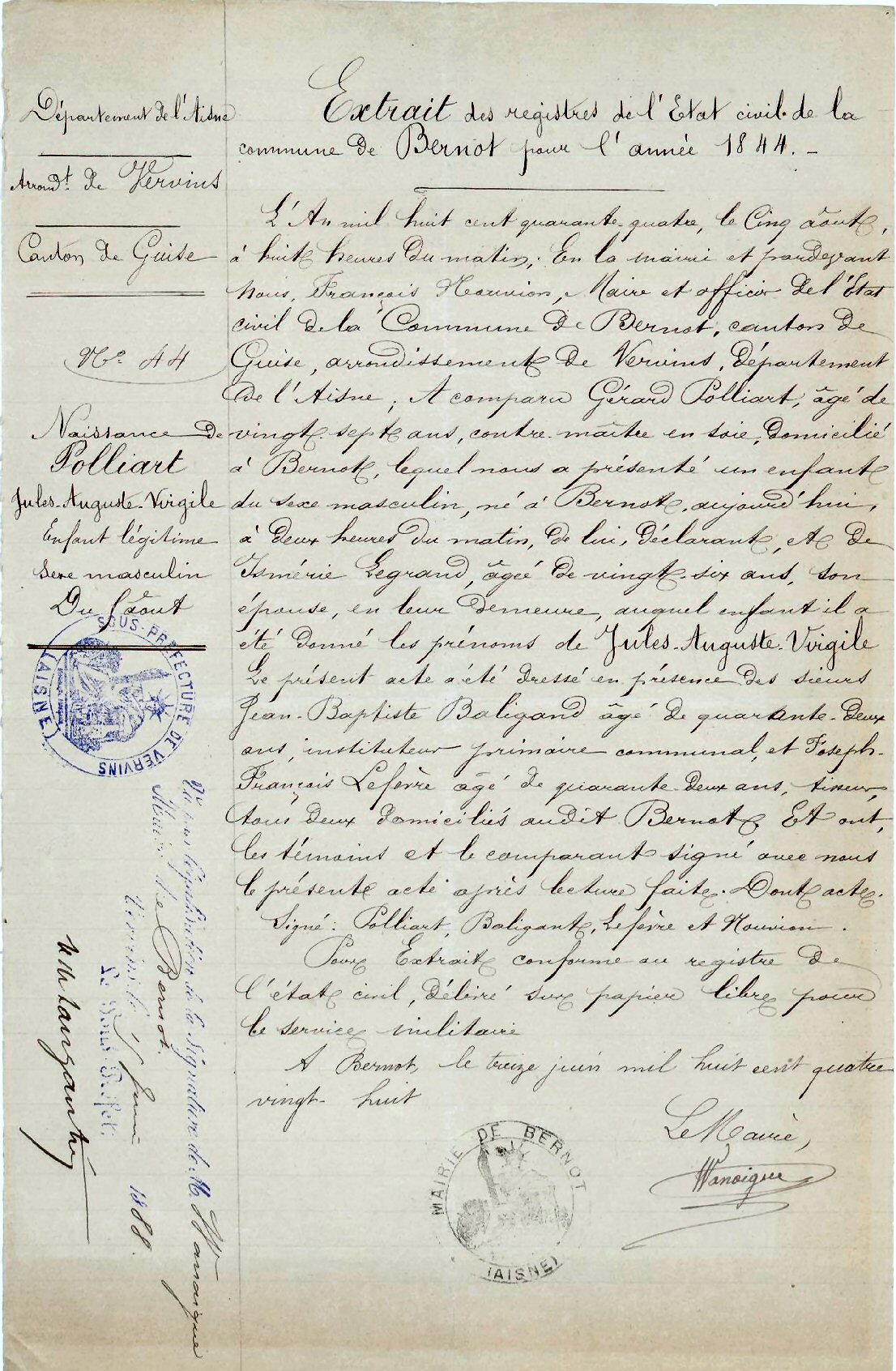
Polliart Chevalier de la Légion d'honneur 1889
Polliart 1889 chevalier de la Légion d'honneur
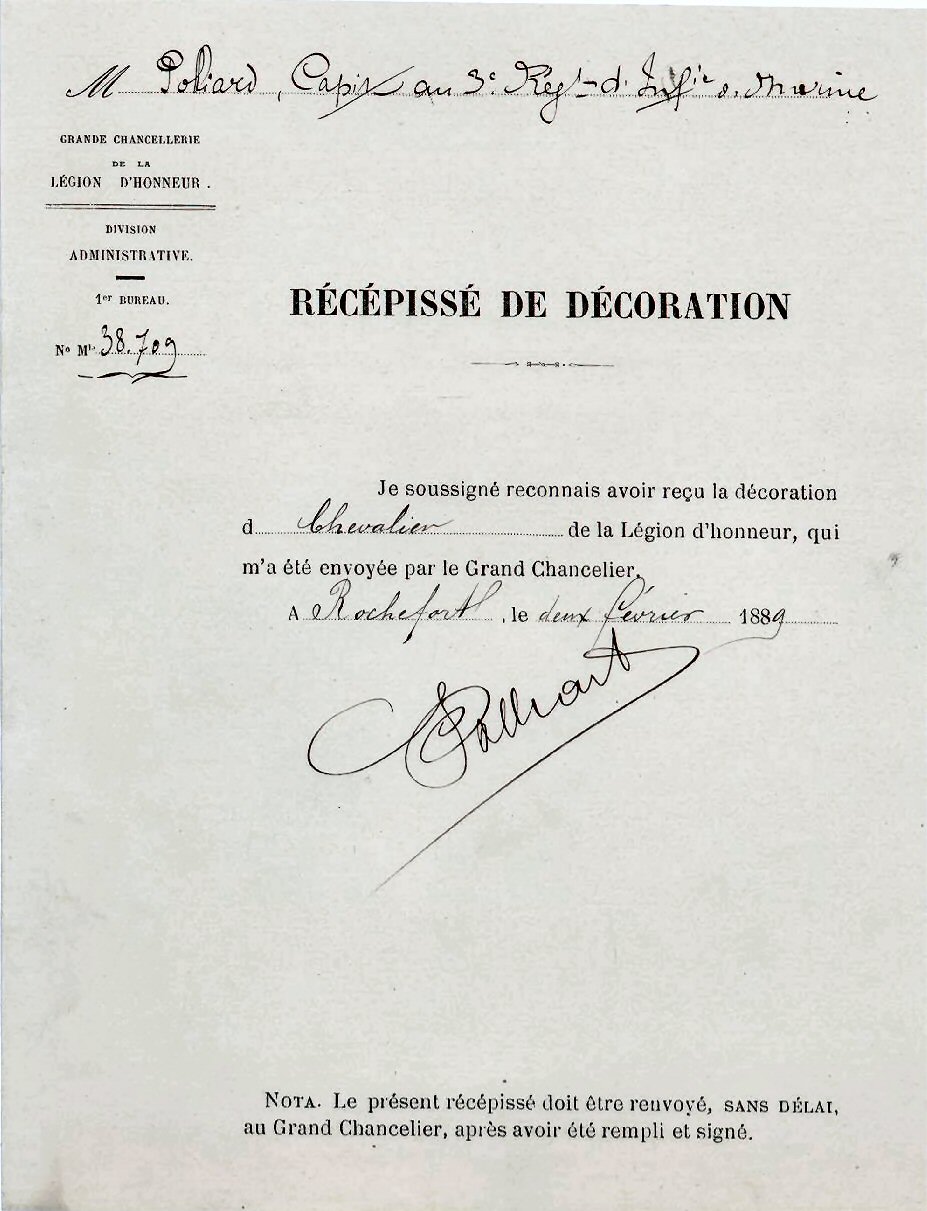
Polliart Chevalier de la Légion d'honneur 1889
Polliart military service I
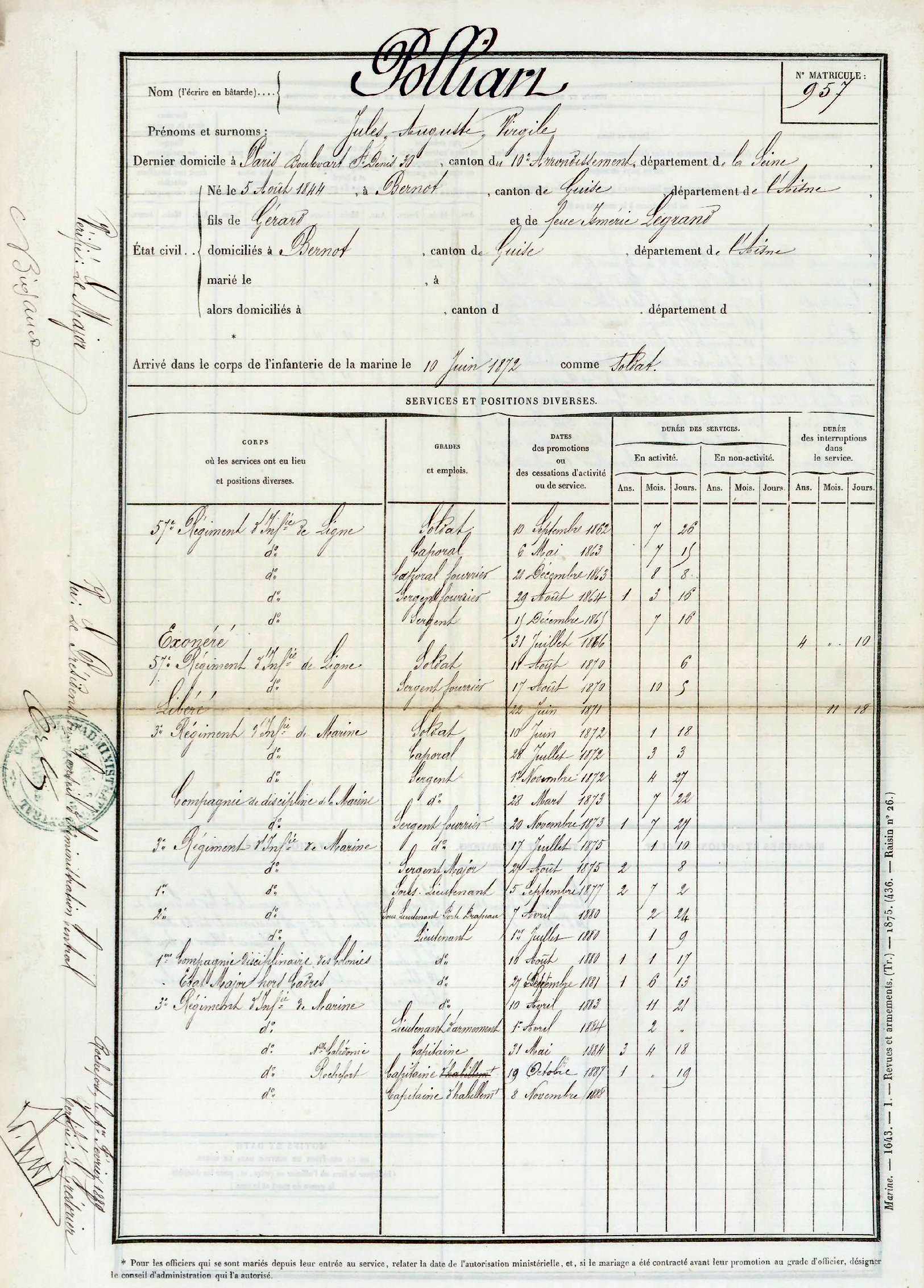
Polliart military service 1862 - 1888
Polliart military service II
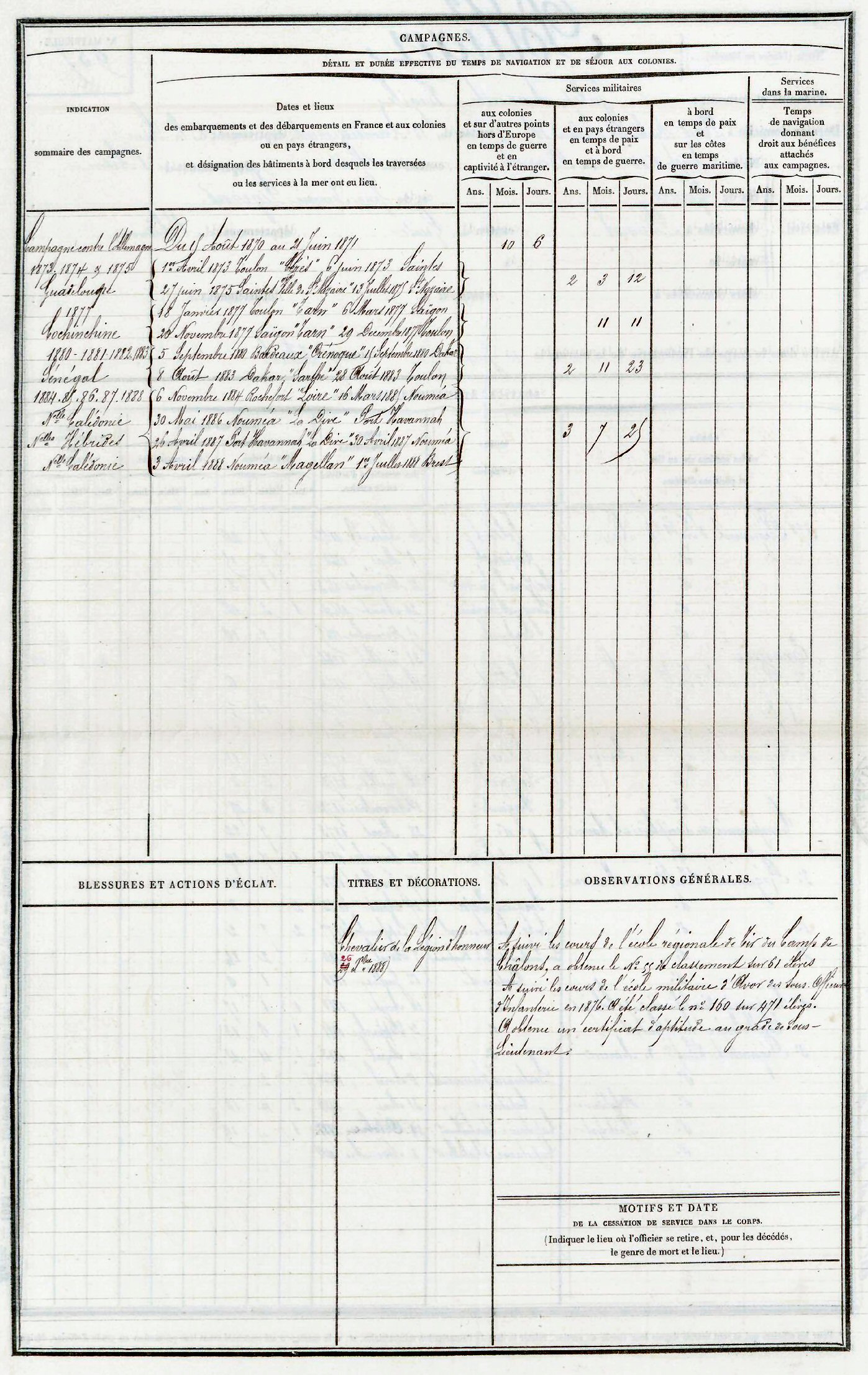
Polliart military service 1862 - 1888
Source: Archives Nationales Paris

The 1886 Polliart cover
preliminary collection of information
Cover sent by Captain Jules Auguste Virgile POLLIART (* 5.8.1844, + 4.1.1901), (sometimes quoted as E. Polliart), commander of the French military detachment in the New Hebrides which was stationed
at Port Havannah (Vaté or Sandwich Island in these early times) to Monsieur Bosmorin in LÈGE, canton d'Audenge, department Gironde.
Front:
voie française (French routing) - détachement des Nouvelles Hébrides
Cachet of the 3rd marine infantry regiment / second part New Caledonia in blue (3ème régiment d'infanterie de marine / portion secondaire Nelle Calédonie).
Octagonal cachet Army correspondence NOUMEA 12 AOUT 86 in black (correspondance d'armée: CORR. D. ARM. NOUMEA)
Circular cachet army correspondence line T french paquebot No.2 7 SEPT 86 in red (correspondance d'armée ligne T paquebot français)
A red ink tax remark 30c and the triangular T in black.
Tax stamp type Duval : 30c.
Reverse:
written in mauscript: the Captain and Commander of the detachment (le Capitaine Commandant le détachement) and signed POLLIART.
Cachet of the 3rd marine infantry regiment.
Mobile cachet CETTE A BORDEAUX (xx oct xx) and BORDEAUX (17h xx xx xx) in transit and ARES GIRONDE 22 OCT xx on arrival.
This cover did not enjoy the benefit of the military rate reserved to units in action in foreign territory like during the time
of the expedition corps in Madagascar in June 1885. It should have been franked with the reduced military correspondence rate of
15c for a 15gr letter (since 1st May 1878) therefore it was taxed 30c.
Military Concession Rate:
Concession rate of 15c per 15 g in lieu of 25c overseas rate to France and the French Community
Required a manuscript endorsement and signature of unit commander or unit cachet to validate the concession rate
It may be possible that Monsieur Polliart thought that his unit was in action and therefore the letter didn't need a stamp.

12 August 1886
Polliart cover. ("SeSi" coll.)

12 August 1886
Polliart cover. ("SeSi" coll.)

signatures 1886 / 1889
Comparison of three Polliart signatures to confirm that the one on the cover is genuine: at top: this cover,
next: from a drawing Polliart made on 3 August 1886 in Port Havannah, at bottom: from his 1889 Chevalier de la Légion d'honneur certificate.
Cachet of the 3rd marine infantry regiment / second part New Caledonia in blue.
"3E REGIMENT D'INFIE DE MARINE / PORTION SECONDAIRE NELLE CALEDONIE"
(Image graphically optimised a bit)

Cachet 3rd regiment
Cachet 3rd marine infantry regiment / part two New Caledonia
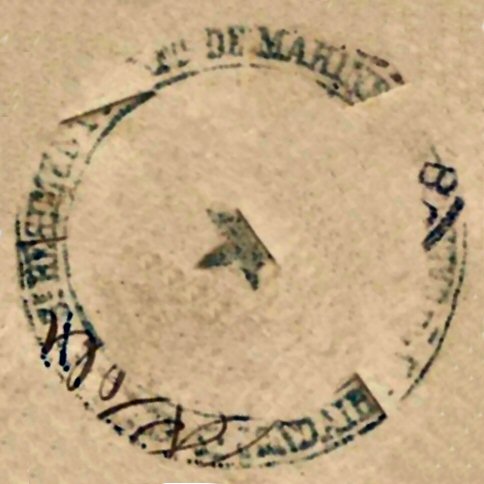
Cachet on reverse
Cachet 3rd marine infantry regiment / part two New Caledonia
Noumea cancel "CORR. D. ARM. NOUMEA" 12 AOUT 86
For a comparison two complete postmarks aside.
(Images graphically optimised a bit)

Noumea army cancel
Noumea military mail cancel
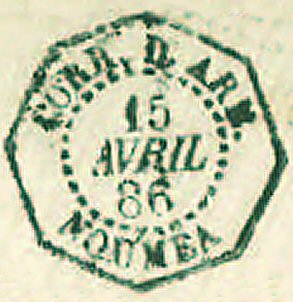
comparison #1
Noumea military mail cancel
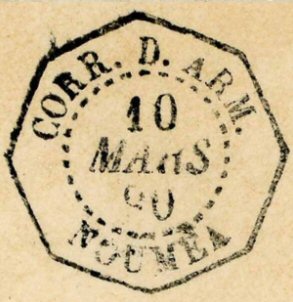
comparison #2
Noumea military mail cancel
7 September 1886: COR. D. ARM. / LIGNE (T) PAQ. FR. N°2 cancel.
(Images graphically optimised a bit)
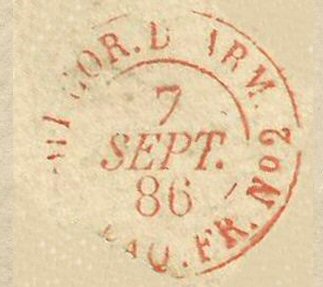
7 September 1886
7 September 1886: COR. D. ARM. / LIGNE (T) PAQ. FR. N°2 cancel
..and the T cachet
(Image graphically optimised a bit)
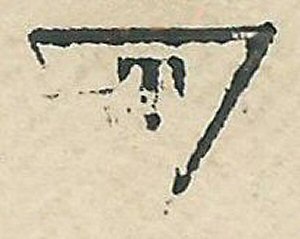
T-cachet
T-cachet
CETTE (Sète) xx oct (1886) cancel
BORDEAUX xx xxx xx(86) cancel.
ARES GIRONDE 22 OCT (86) cancel.
(Images graphically optimised a bit)

xx oct (1886)
xx oct (1886) CETTE
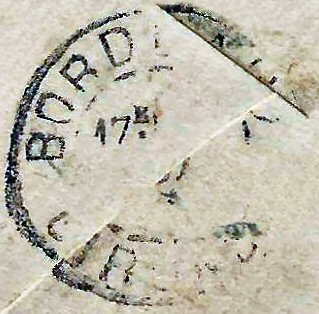
xx xxx (1886)
xx xxx (1886) BORDEAUX

22 October (1886)
22 October (1886) ARES GIRONDE cancel


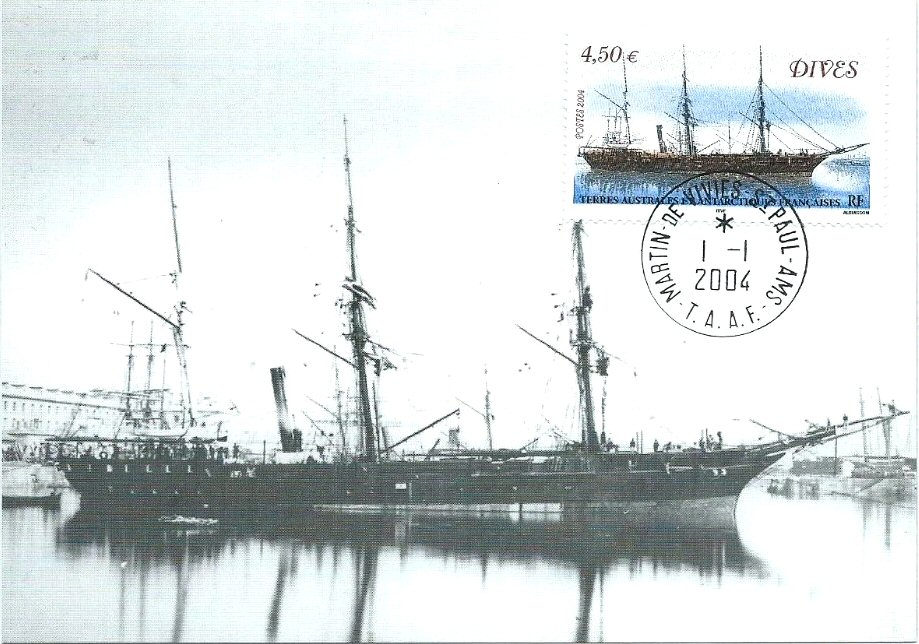
Aviso La Dives
La Dives aviso transport mixte
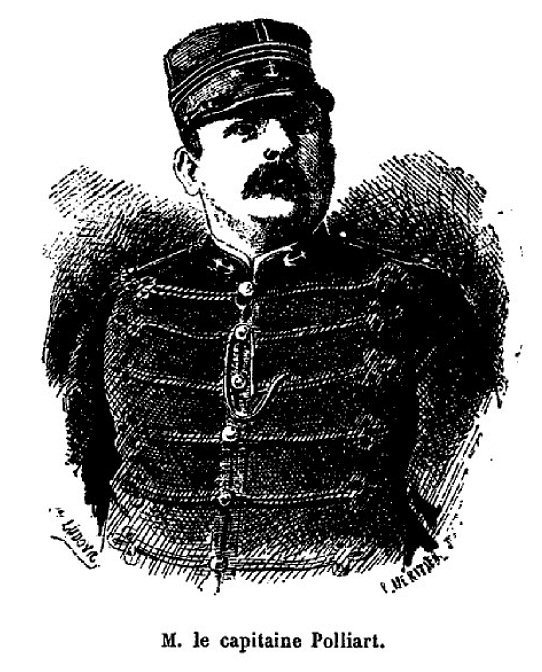
Capt. Polliart 1886
Capt. Polliart 1886 - source: Bulletin de la Société de géographie commerciale de Paris
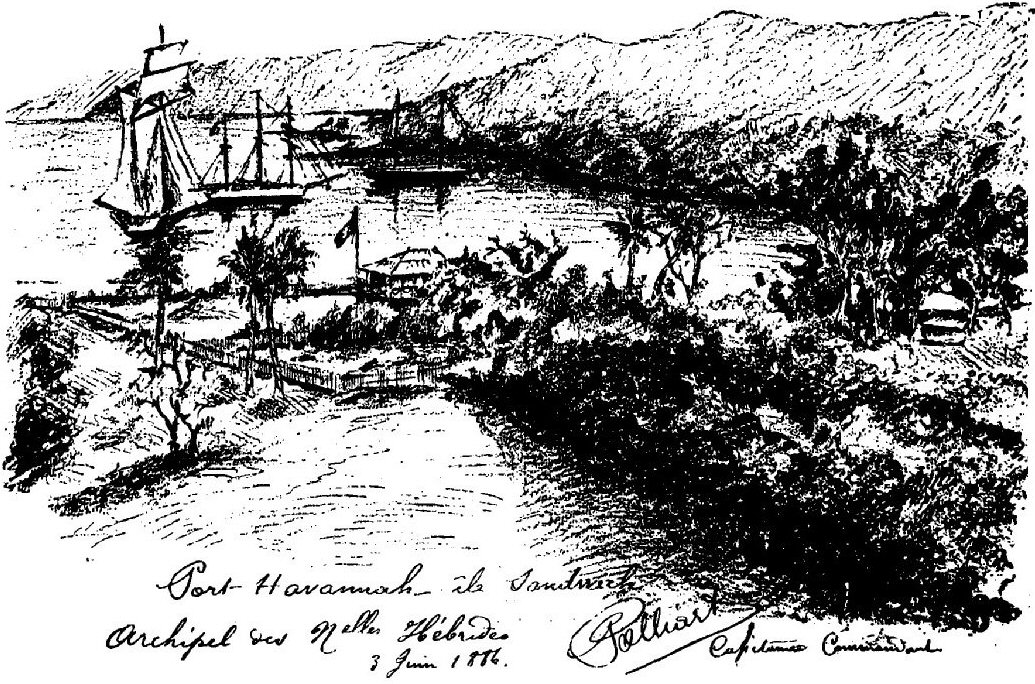
Polliart drawing 1886
1886 Polliart drawing of Port Havannah - source: Bulletin de la Société de géographie commerciale de Paris

Here I can show an article which Monsieur Polliart wrote about the events in the New Hebrides and which was published in the
Bulletin de la Société de géographie commerciale de Paris. It could be that his report was sent with the above letter.
As Monsieur Polliart wrote the second part of the article in Noumea on 5 August he may have been there too when the above cover was posted on
12 August 1886. --- Of course this is the French view of things!!!
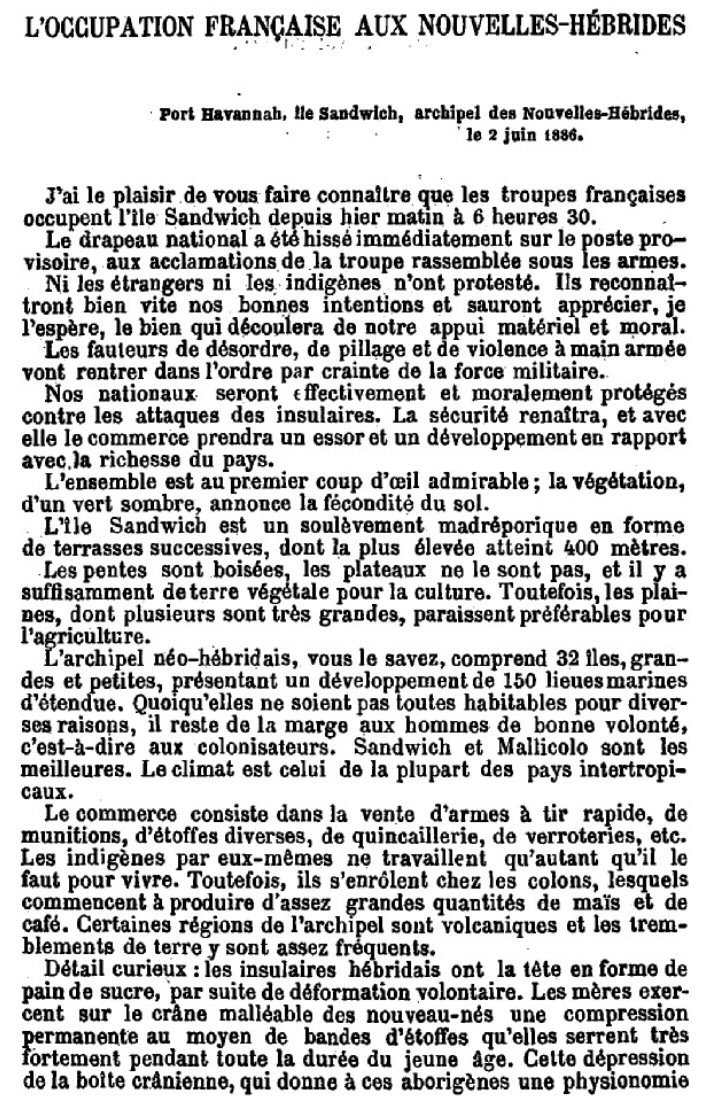
Polliart Text 1
1886 Polliart article part 1 - source: Bulletin de la Société de géographie commerciale de Paris
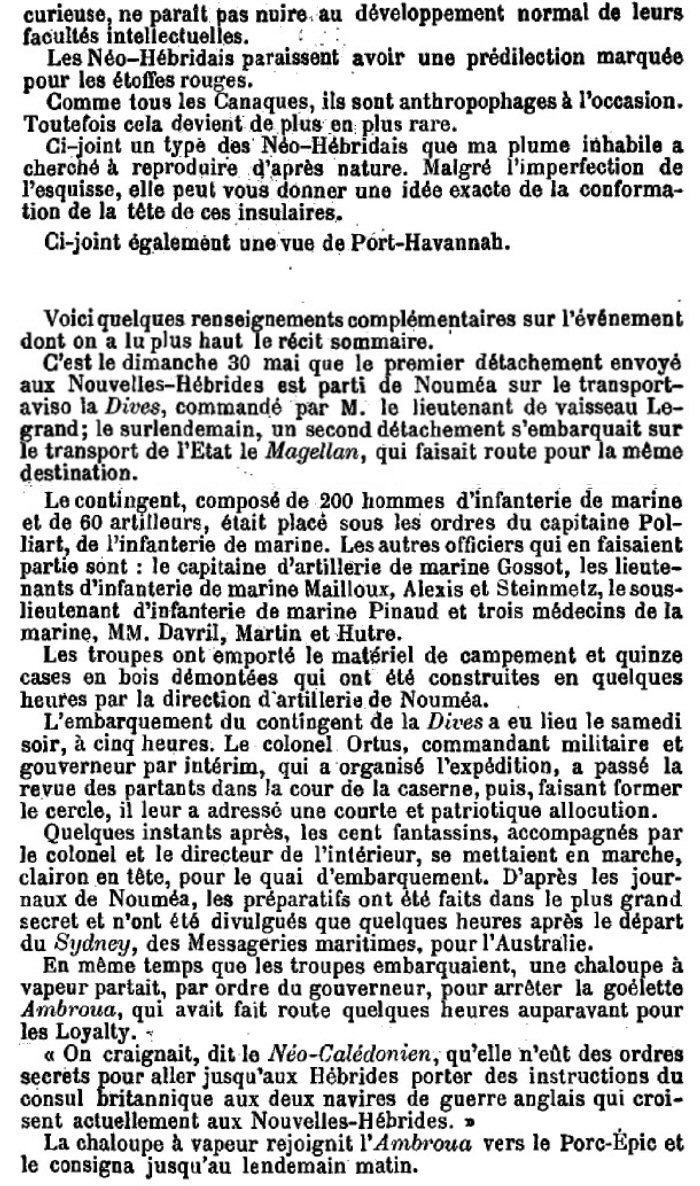
Polliart Text 2
1886 Polliart article part 2 - source: Bulletin de la Société de géographie commerciale de Paris
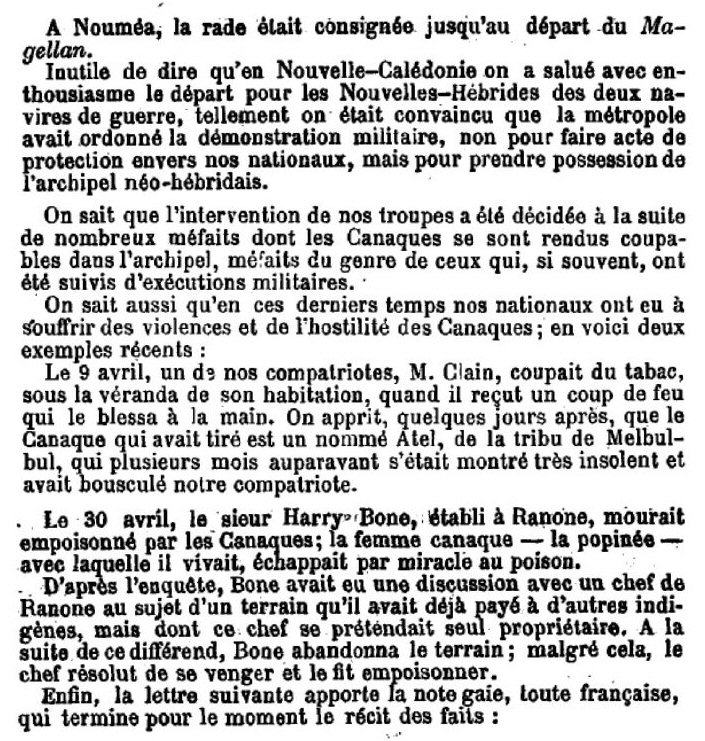
Polliart Text 3
1886 Polliart article part 3 - source: Bulletin de la Société de géographie commerciale de Paris
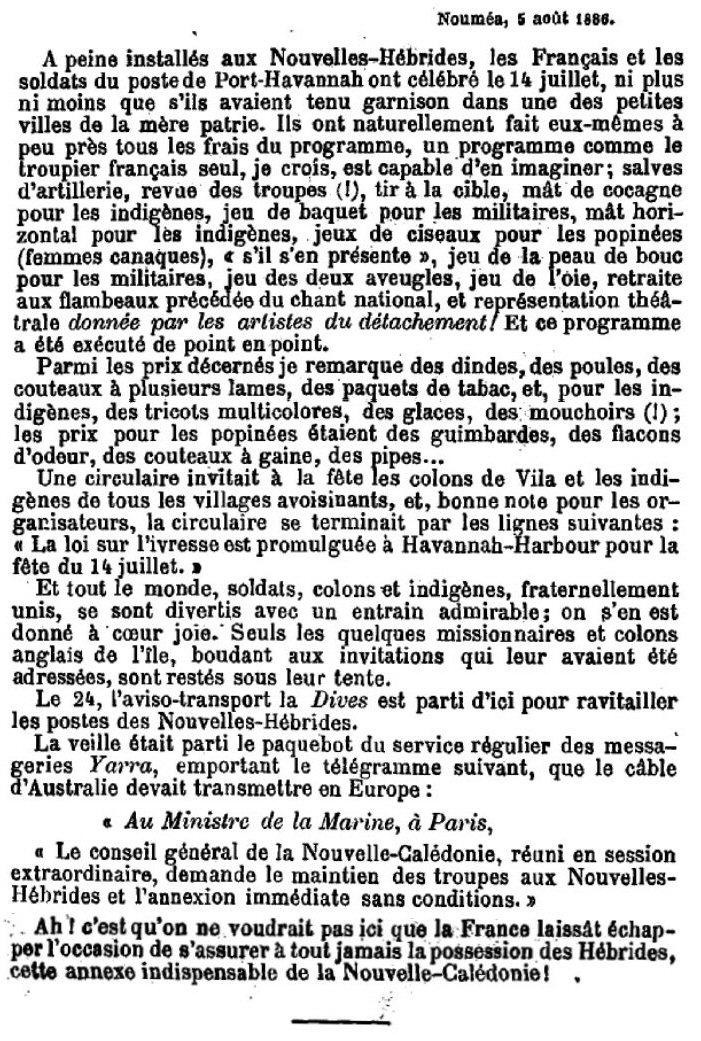
Polliart Text 4
1886 Polliart article part 4 - source: Bulletin de la Société de géographie commerciale de Paris

In the same periodical (Bulletin de la Société de géographie commerciale de Paris 1886/87) Polliart wrote an article
about the New Hebrides. Interesting the last paragraph where he describes the character of the natives:
"I want to add that the New-Hebrideans do not practise slavery, that they govern and conduct intelligently and - if they are treated
with smoothness and fairness - become truthful, hospitable, corteous, faithful and even likeable to a certain degree. There are nearly
no incidents that a New-Hebridean attacked first and without reason.
When he killed an isolated settler this only happened after thousands of humiliations and numerous injustices so that he decided
to retaliate. These natives never forgive others for taking away a girl or a woman. The honesty of these islanders is admirable;
there doesn't exist a single thief in the midst of these savages in this archipelago."
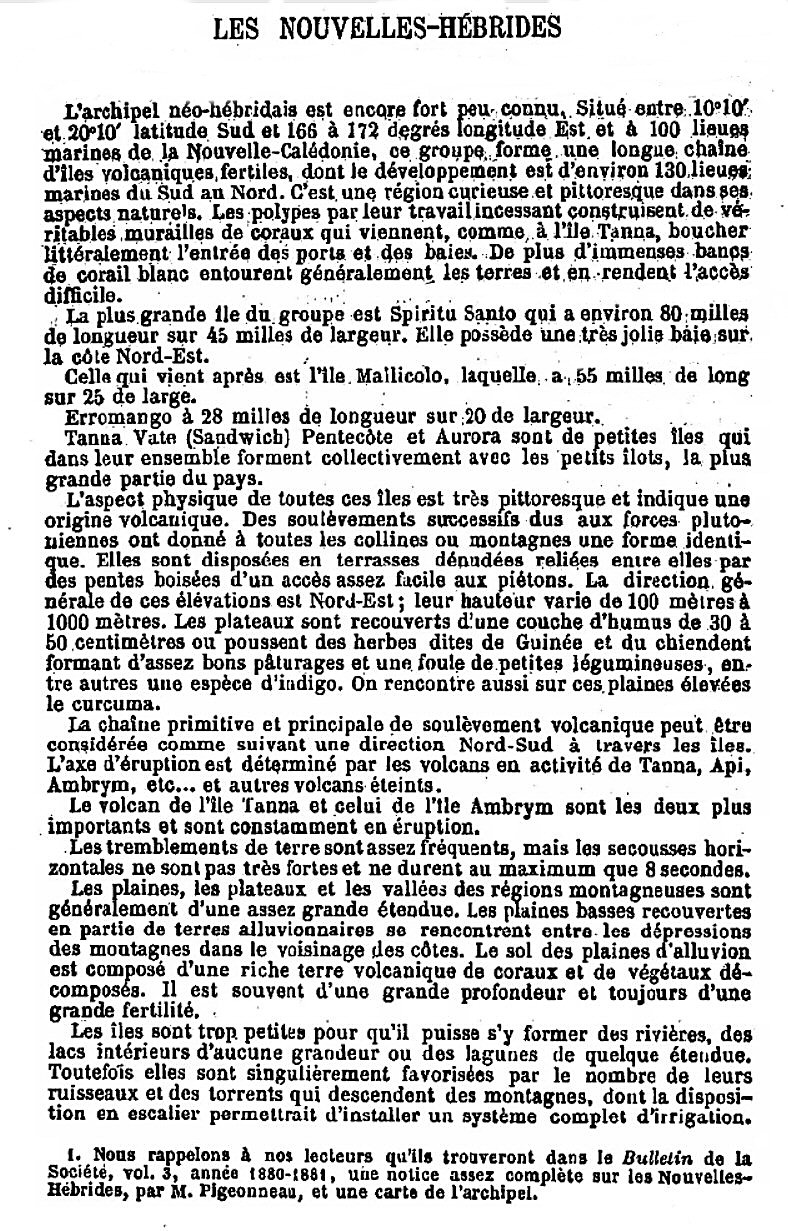
Polliart NH 1
1886 Polliart Nouvelles-Hébrides part 1 - source: Bulletin de la Société de géographie commerciale de Paris
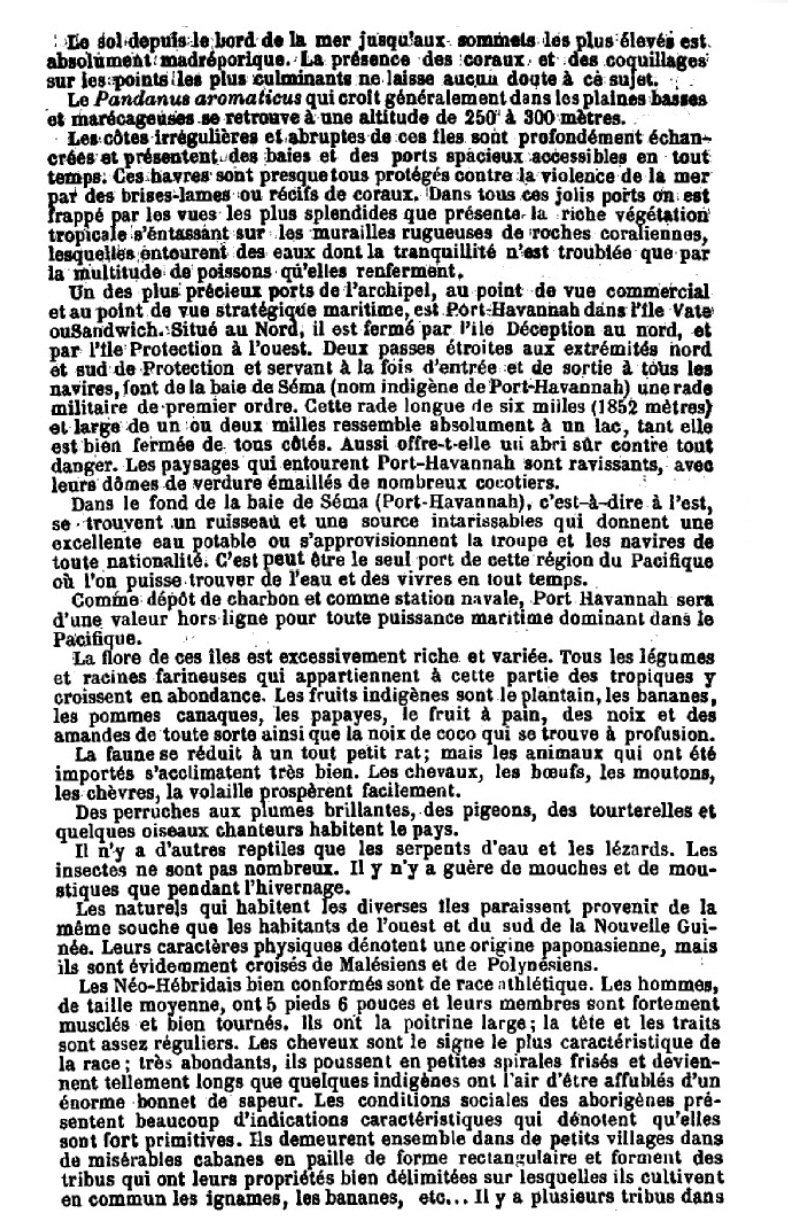
Polliart NH 2
1886 Polliart Nouvelles-Hébrides part 2 - source: Bulletin de la Société de géographie commerciale de Paris
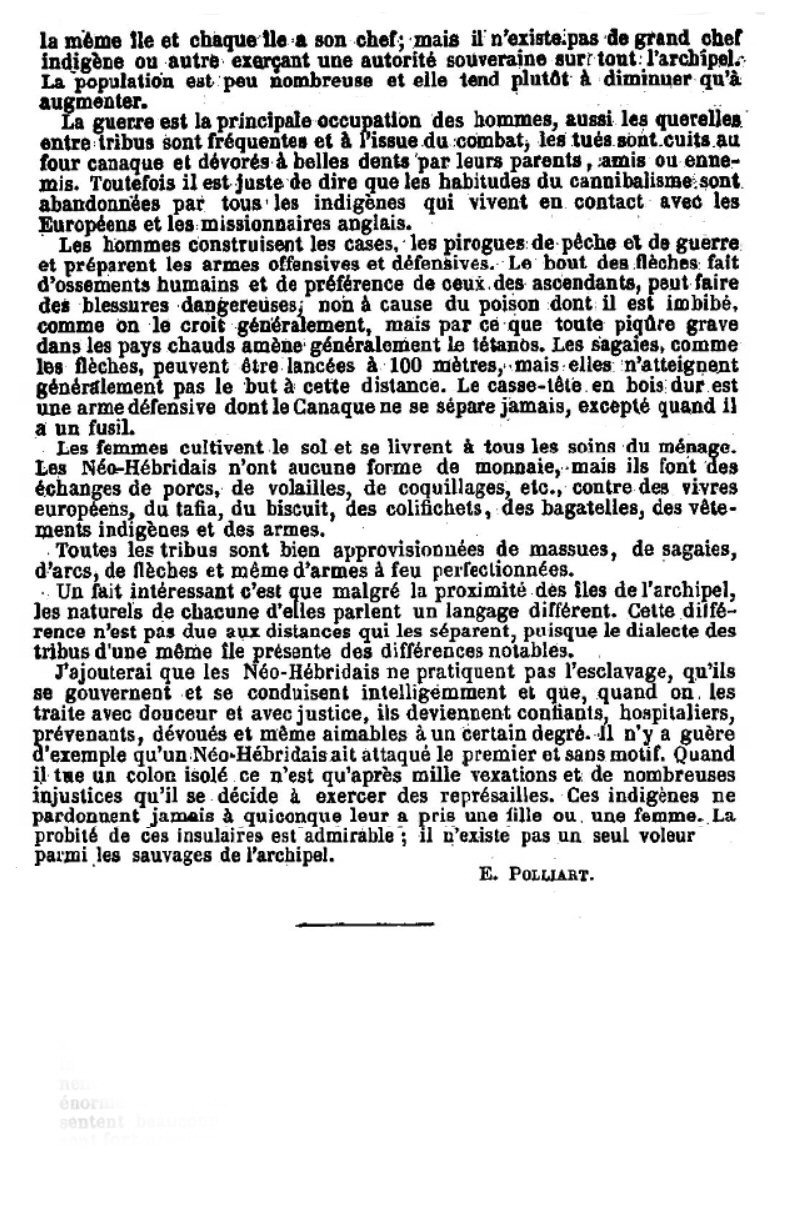
Polliart NH 3
1886 Polliart Nouvelles-Hébrides part 3 - source: Bulletin de la Société de géographie commerciale de Paris

A first try to compile the routing of this letter:
During the month of August 1886 four French warships were engaged in this operation together with the transport ship MAGELLAN:
LA DIVES, DUCHAFFAUT (Cdt Palma Firmin Christian GOURDON), ALLIER and GUICHEN. All four were in Noumea about 15 August just after this
cover was cancelled. The DIVES made regular trips between Noumea and the New Hebrides to provide mails for the soldiers.
CALEDONIEN capt Henri de Maubeuge left Sydney to Noumea on August 14. She left Noumea for Sydney on August 21 so
she could easily take this letter with her. She was back in Sydney on 25 August and left for Marseilles on 7 September.
Via Mauritius, Mahé and Réunion she passed Aden on 8 Oct, Port Said on 15 Oct and arrived in Marseilles on 20 October,
two days ahead of her contract time.
 The following text by "SeSi", the now owner of this cover:
The following text by "SeSi", the now owner of this cover:
Port Havannah - Nouméa: Aviso La DIVES qui patrouillait dans l'archipel des NH pour affirmer
la présence française et qui relâchait une fois par mois à Port Havannah pour ravitailler le camp
en nourriture , matériel et pour évacuer les soldats victimes des fièvres et de la malaria.
Marseille - Bordeaux : par train (620 km).
La construction de la ligne de chemin de fer devant relier l'océan atlantique à la mer méditerranée
suivant l'axe Bordeaux-Toulouse-Cette-Marseille a été décidée le 14 juin 1845 et achevée en 1857.
(Cette : ancienne orthographe de Sète).
Arrivée à Arès le 22 octobre pour distribution à Lège (Lège-Cap-Ferret) le jour même.
Lorsque Adolphe Le Boucher premier gouverneur civil de la Nouvelle Calédonie quitte ses fonctions
le 13 mai 1886, c'est le Lieutenant-Colonel Jacques-Marie-Benjamin-Arthur ORTUS qui assure
l'intérim pendant 3 semaines jusqu'au 5 juin 1886 date de prise de fonction de Louis Nouët (05.06.86
-30.07.88).
Pendant ce bref laps de temps, il prend la décision d'envoyer un détachement d'infanterie de marine
à Port-Havannah (Vaté) et à Port Sandwich (Mallicolo) pour faire respecter les vies des sujets français
menacés aux NH (version française) ou pour annexer l'archipel (version anglaise).
En moins de 20 heures, 200 fantassins et 60 artilleurs sont prêts à embarquer avec leur matériel, leurs
armes, des matériaux de construction et 3 mois de vivres.
L'aviso La DIVES commandé par le Lieutenant LEGRAND quitte Nouméa le dimanche 30 mai pour
Port-Havannah où il arrive le 01 juin à 6h00 du matin. 100 fantassins et 40 artilleurs débarquent et
installent un campement sous les ordres du Capitaine E. POLLIART commandant le détachement du
3ème régiment d'infanterie de marine, sur les terrains de monsieur Alphonse Bernier, chef de l'agence
de la Compagnie Calédonienne des Nouvelles Hébrides à Vaté.
La DIVES jette l'ancre à Port Sandwich le 2 juin à 9h50 pour débarquer le reste de la troupe sous les ordres
du Sous-Lieutenant PICARD.
Elle est rejointe sur place le 4 juin par le transport MAGELLAN parti de Nouméa le1er avec les pièces d'artillerie
et les matériaux lourds.
Après transbordement des équipements destinés au camp du Capitaine POLLIART, La DIVES repart pour
Port-Havannah où le matériel est débarqué le 06.
Le retour sur Nouméa se fait le 07 pour une arrivée triomphale le 9 juin à midi.
La nouvelle d'un débarquement de troupes françaises aux NH s'est répandue comme une trainée de poudre
dans les colonies anglaises du pacifique sud. La presse australienne déclancha une violente campagne anti
française soutenue principalement par les Presbytériens.
Après une période de forte tension et pour éviter une crise diplomatique majeure entre la France et la Grande
Bretagne les deux gouvernements ont repris les négociations sur l'avenir de l'archipel, ce qui abouti le
16 novembre 1887 à la signature d'une convention de principe pour organiser une commission navale mixte
chargée "d'assurer la protection des personnes et des biens aux Nouvelles Hébrides".
La création de la commission est signée le 26 janvier 1888 avec un fonctionnement officiel à partir du 1 mars 1888.
Le 14 mars La DIVES et Le VOLTA évacuent les postes militaires français.
Cette lettre emblématique de l'histoire des NH témoigne de l'évènement clé qui fut à l'origine d'un processus
de près de 20 ans qui devait conduire à la création du Condominium.

I just found out that in her book "The Making of a Rebel - Captain Donald Macleod of the New Hebrides"* the author
Katherine Stirling Kerr Cawsey wrote an extensive chapter about these events: "Chapter 20 - French Invasion of the New Hebrides, 1886".
* : Institute of Pacific Studies, University of the South Pacific, 1998
Captain Polliart is mentioned very often in this chapter. These sentences here are especially important regarding the cover above:
"Cross [Lt. Cdr. RN, HMS UNDINE] was in Havannah Harbour on 30 July [1886] when the CCNH [Compagnie calédonienne des Nouvelles Hébrides]
Director demanded to see Macleod's land title but left for the north before Polliart fronted up to Macleod with a "Procès Verbale"
and a "Réquisition Militaire" on 7 August. ..... Polliart gave him 24 hours to pull it down [a fence] and produce his title.
and:
.... SWINGER arrived [in Port Havannah] followed by UNDINE on 16 August. Cross [commander of UNDINE] instead of questioning Macleod and Macdonald
[English missionary] first, went straight to Polliart ........
These two remarks tell us that Polliart was back in Port Havannah during the time the letter was posted in Noumea after his stay there
on 2 August when writing the last part of his article above "L'Occupation Française ....". So it is very supposable that the letter
was written in Port Havannah and then brought to Noumea maybe by the DIVES but there were many other ships too commuting between Port Havannah
and Noumea.

From French contemporary
newspapers:

9 October 1886
9 October 1886: "LA FRANCE COLONIALE"
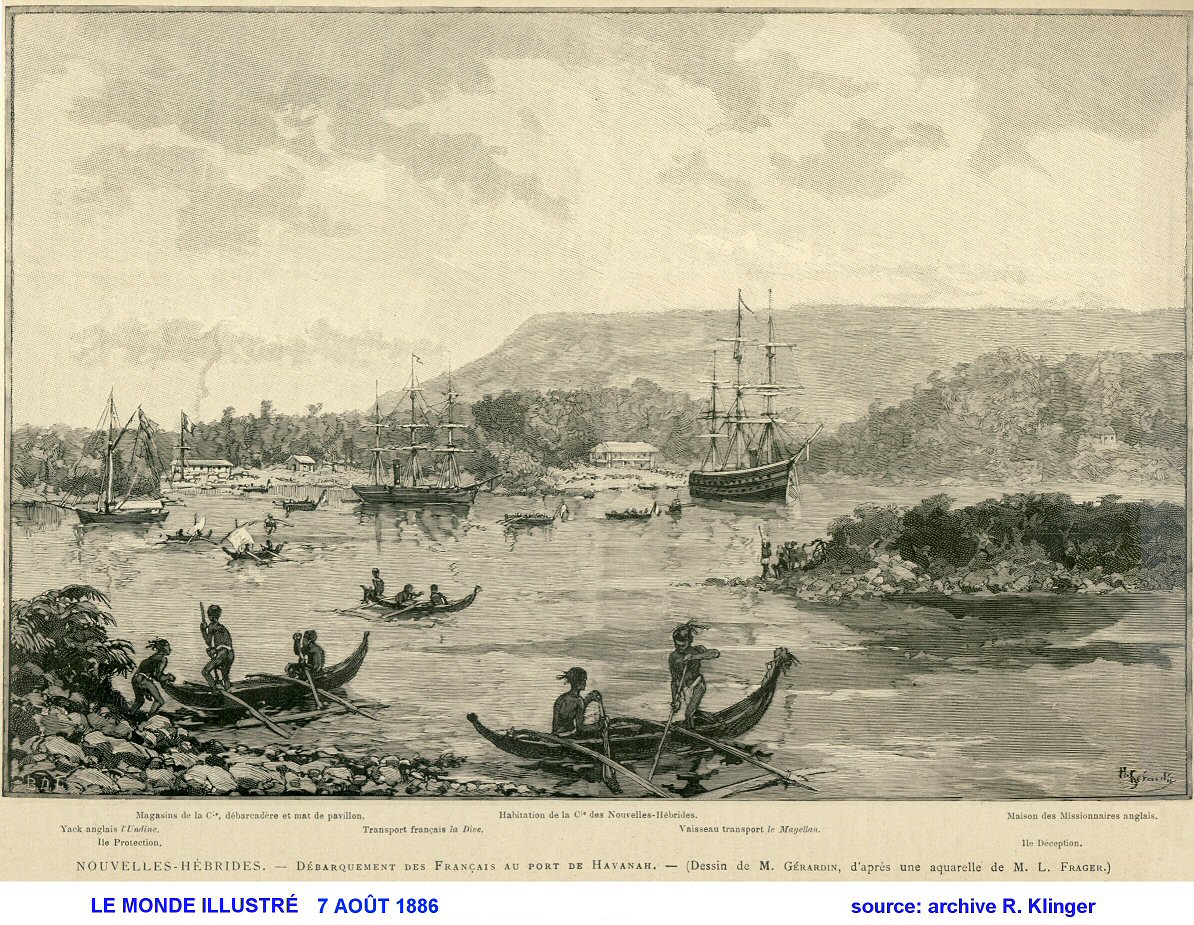
1 August 1886
7 August 1886: "LE MONDE ILLUSTRÉ" Port Havannah
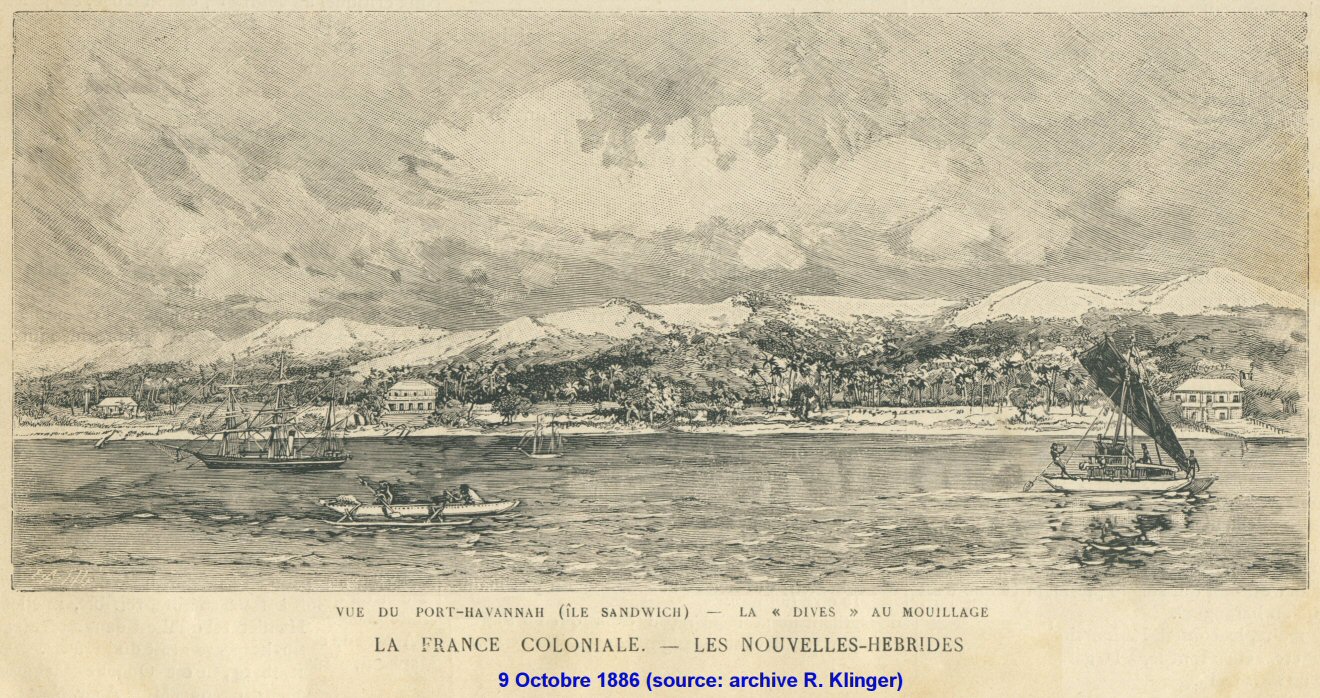
9 October 1886
9 October 1886: "LA DIVES" in Port Havannah

9 October 1886
9 October 1886: "LE MAGELLAN" coming

9 October 1886
9 October 1886: Title of the newspaper
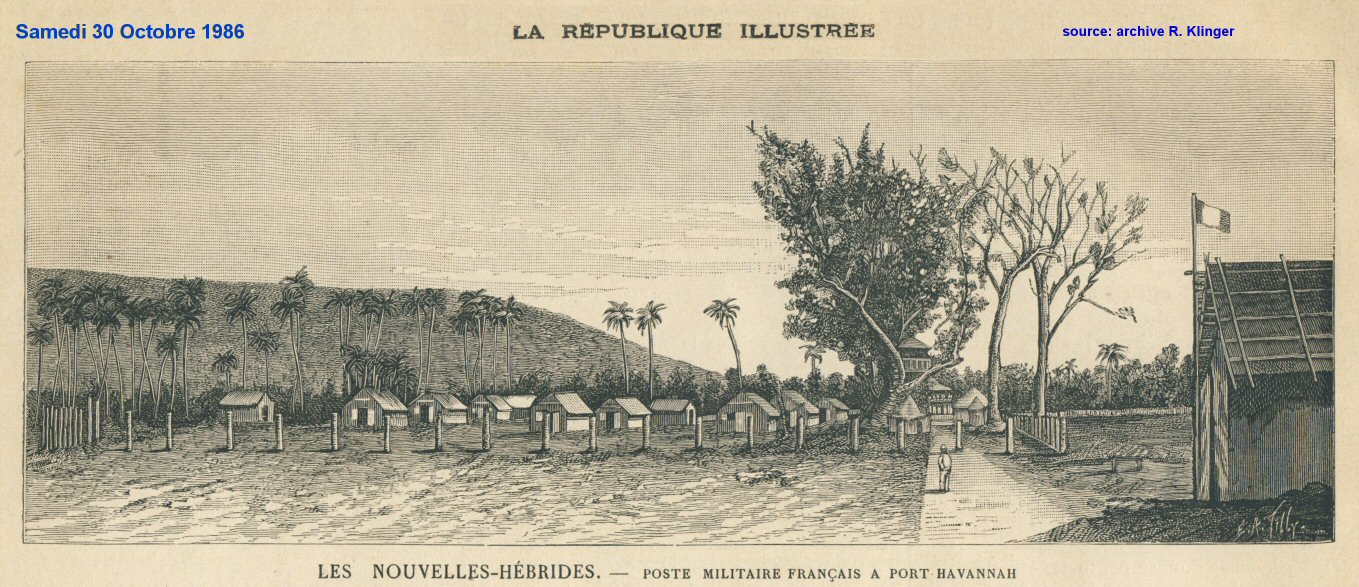
30 October 1886
30 October 1886: military post at Port Havannah - "LA RÉPUBLIQUE ILLUSTRÉE"
From an English contemporary
newspaper:
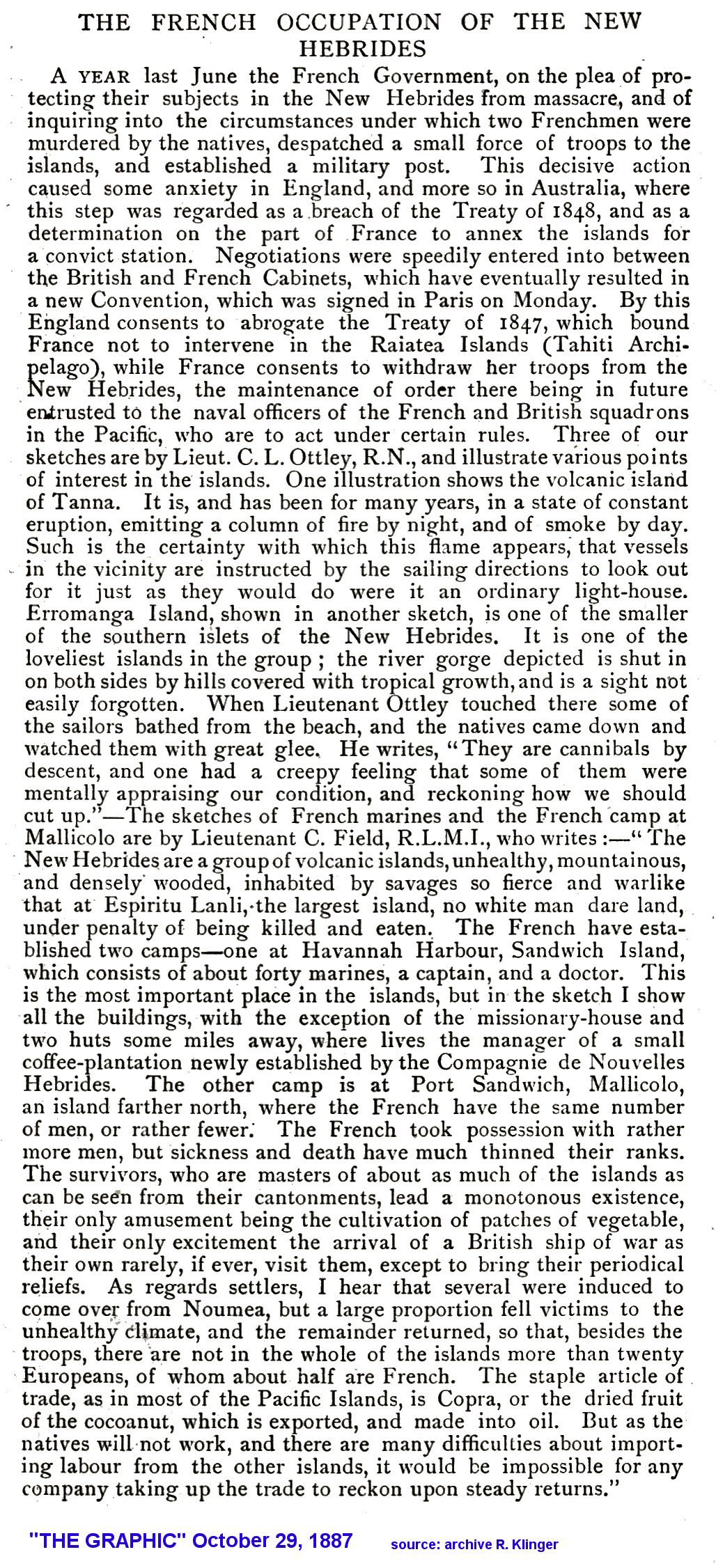
29 October 1887
29 October 1887: "THE GRAPHIC"
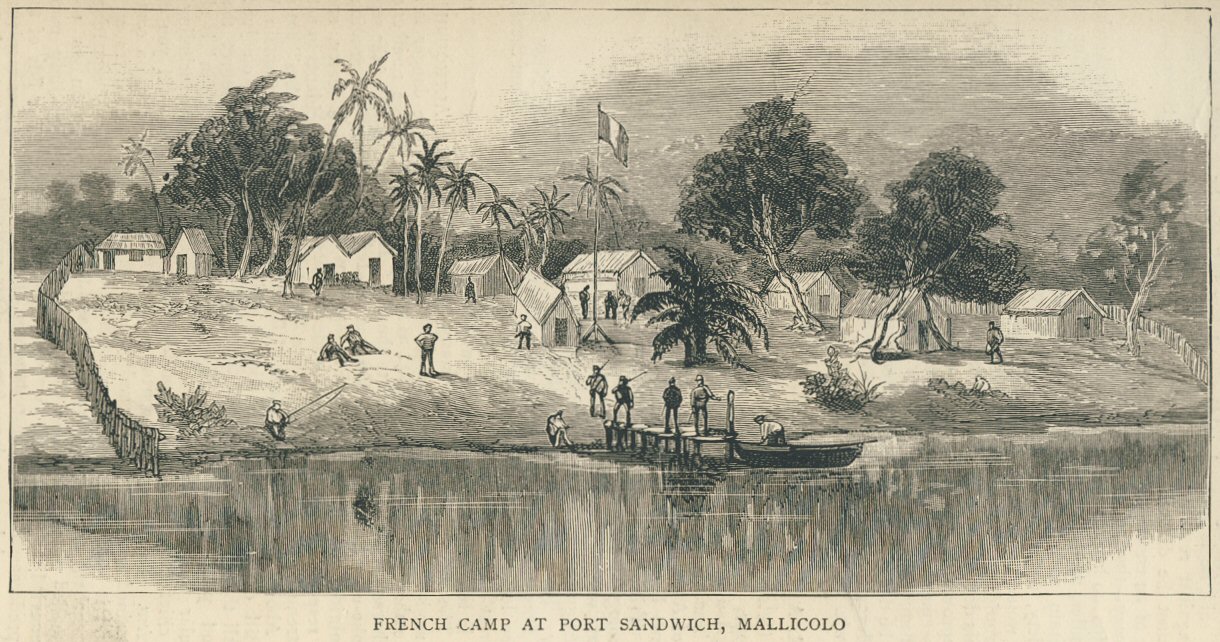
29 October 1887
29 October 1887: French camp at Port Sandwich, Malicolo - "THE GRAPHIC"
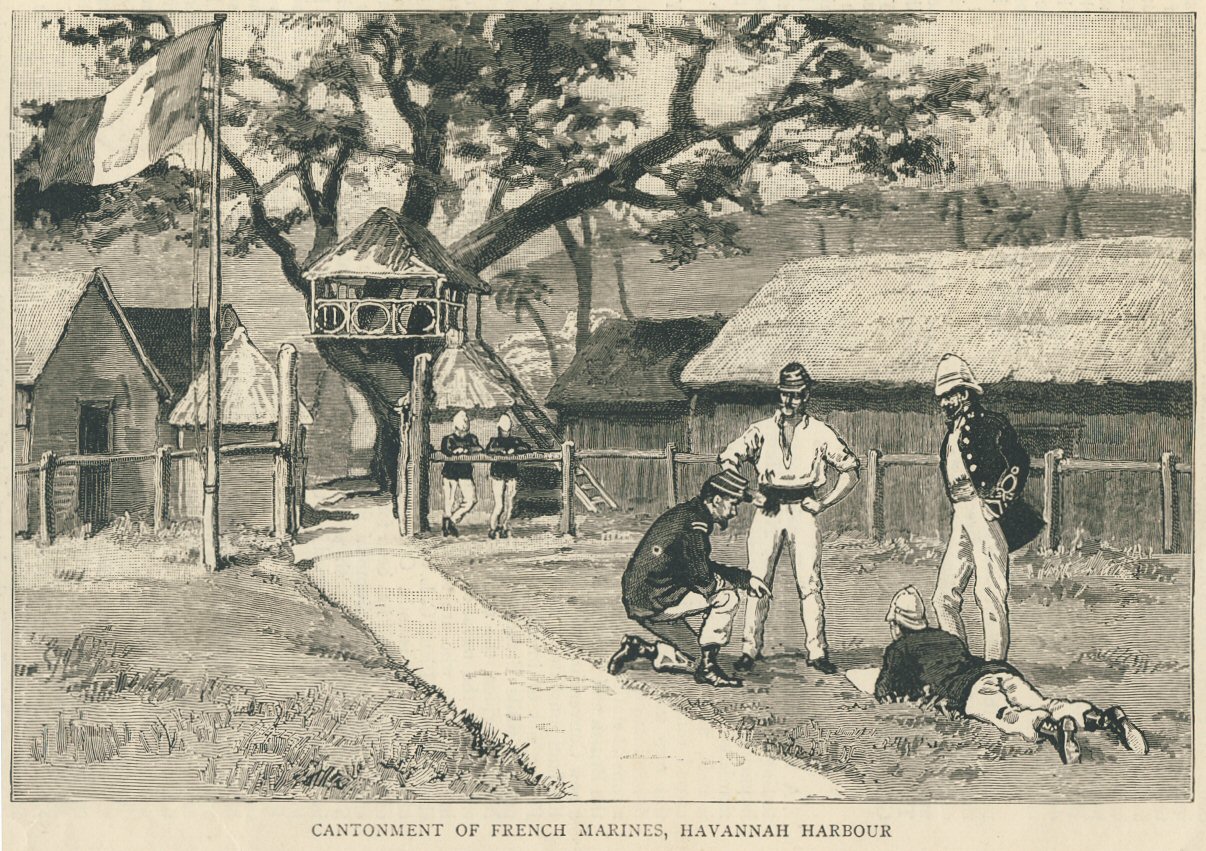
29 October 1887
29 October 1887: Cantonment of French marines, Havannah Harbour - "THE GRAPHIC"

29 October 1887
29 October 1887: Panoramic view of part of Havannah Harbour, Sandwich Island - "THE GRAPHIC"







 The following text by "SeSi", the now owner of this cover:
The following text by "SeSi", the now owner of this cover:






































